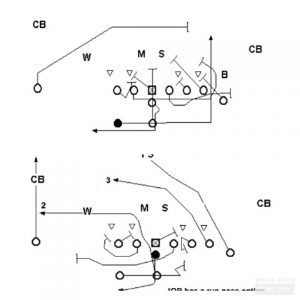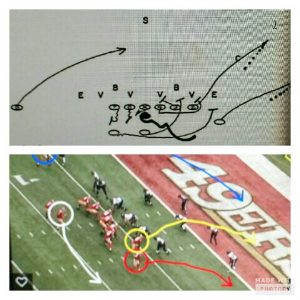College Football: The father of modern day offenses
When thinking about college football history certain names come to mind: Eddie Robinson, Joe Paterno, Bobby Bowden, Bear Bryant, Knute Rockne, etc. Each of these coaches made a tremendous impact at their respective universities, conferences and the country. Their offices are littered with National Championship trophies, Conference Championship’s, coach of the year awards. Countless All-American’s, and NFL players went through the program None of them, however, changed the game of football like Harold “Tubby” Raymond. Tubby Raymond coached at Delaware from 1966-2001 winning 300 games with a winning percentage of just over 71%. Raymond’s win-loss record is certainly impressive, but that is not his only contribution to the game of football. His offensive system, the Wing-T is being run all over college football and the NFL.
The Wing-T offense was created by Delaware head coach David Nelson during the 1950’s. Nelson merged two offenses that were prevalent during College Football during the 50’s.The Single Wing and the T-Formation. More detailed information about David Nelson and the Wing-T can be found here. The Single Wing requires a quarterback that can run between the tackles and have enough speed to turn the corner. The quarterback must also pass well enough to threaten the defense with both the run and the pass. As you can imagine these quarterbacks are hard to find. Tim Tebow, Cam Newton are the ideal quarterbacks to run to the Single Wing. Both Tebow and Newton won Heisman trophy’s and had some of the best seasons by a quarterback in the SEC. Delaware would almost have zero shot of recruiting that type of athlete, so Nelson took concepts of the Single Wing (Pulling Lineman, Trap blocking, Mis-direction) and applied these concepts to the three back, quarterback under center offense of the T formation. In 1954 Tubby Raymond joined the staff as an offensive coordinator and the Wing-T took off. Much like Barry Switzer perfected the wishbone Raymond perfected the Wing-T by modernizing and advancing the Wing-T into the offense many know today as the Delaware Wing-T.
The Wing-T is more than a formation or a play. It is a theory of offense. The book Delaware Wing-T the Order of Football by Raymond is a masterpiece of a book that any football fan should read. The first hundred or so pages of the book explain Raymond’s reasoning behind different formations, motions, and series based offense. A series of plays is in reference to a collection of plays that all fall under a set. Each set is designed to threaten the defense in multiple ways creating conflicts for each defender.

For example, the buck sweep set of the Wing-T has three plays that all look similar and start off the same way. On the buck sweep, the quarterback starts with a fake to the fullback up the middle to delay the linebacker and allow the two pulling guards to get outside and lead the way for the tailback. The quarterback then carries out a fake after handing the ball off. The second play of the set, the Trap, follows the same movement with one exception the quarterback hands the ball off to the fullback. Also within the set is the waggle pass, the waggle follows the same backfield movement as the buck and trap with the full-back sneaking out of the backfield and the quarterback rolling to the split-end side with the run/pass option. Three plays that look exactly alike that punish defenses that adjust. Slant your defensive tackles to the outside to stop the buck sweep, the full-back runs the ball up the gut. Back-side linebackers cheat strong side, the quarterback keeps the ball around the edge. Adjust to one play, Wing-T has a counter, the defense adjusts again the Wing-T has a counter to your counter. Modern spread teams use the same concept of series based offense within the inside zone. Inside zone turns into the zone read which turns into a bubble screen.
Another set within the Wing-t that has been copied into today’s college football is the power series. Under the Wing-T play side offensive lineman block down, the fullback kicks out the end man on the line of scrimmage and the back-side guard leads the way for the ball-carrier. Power in the Wing-T is the same power that every team in football uses regardless of scheme. When defenses adjust to the power the counter play is used. Much like any other counter play in football the Wing-T version has the play starting one way then the ball carrier(wing back) going the other way with a convoy of lineman paving the way. Also within the set is a reverse play. In this play, the tailback would take the handoff like in power than hand the ball off to the wing back going in the opposite direction. These three plays are used in nearly every playbook in football.
Two running sets within the Wing-T that are used throughout football. What else can the Wing-T offer in the modern running game?…..Motion. Nelson and Raymond were one of the first coaches to use motion within the offense to create even more conflict for the defense. This opens up the jet sweep/fly sweep to the wing backs or a fake to the wing-back to create hesitation to set up a trap play, power, counter or be another blocker for the tailback or fullback. Teams with great space players use motion as a distraction to create running lanes; when Amari Cooper played for Alabama offensive coordinator Lane Kiffin would motion Cooper in the backfield to open up the inside zone with TJ Yeldon. Chip Kelly used this technique as well with Darren Sproles. Motioning the wing-back can be used for running an option play. Paul Johnson of Georgia Tech motions a tailback on nearly every play to be the pitch aspect of the option or apply misdirection.

Components of the Wing-T running game include; power, counter, reverse, motion, and multiple formations allowing the threat of four different ball-carriers. The passing element of the Wing-T is also being copied throughout college and NFL. The sprint out series within the Wing-T offense includes a sprint out pass

where the wing back runs an arrow route to the flat, the tight end runs a corner route putting the corner and safety in conflict. If the defense is in cover two the corner has to cover the flat route by the wing and the rolling out quarterback; if the safety does not get to the tight-end fast enough then the quarterback has an easy pass downfield. In man coverage the corner takes the flat route, safety takes the tight-end and the outside linebacker must be fast enough to ensure the quarterback does not get outside. This play in the NFL ranks is called the sprint right option.
Deep passes are also cornerstones of the Wing-T. The wing and tight-end both run verticals while the split end and the tailback run vertical routes on the backside. This play the four verticals is copied throughout the league and is a staple throughout the “Air Raid” offense currently being run throughout the Big-12 conference. Mike Leach, an Air-Raid coach uses the four verticals in his offense at Washington State.
Love our content? Check out the GoingFor2 Live Podcast Network!

Tubby Raymond’s Wing-T offense offers both running and passing elements that are currently being used throughout college football and the NFL. Gus Malzahn for example, based his entire offense around Wing-T principles (threatening several areas at once and putting defenders in conflict). A perfect example is the play during the Iron Bowl (Kick Six game) where quarterback Nick Marshall fakes an inside zone to Tre Mason, rolls out and hits Sammie Coats on a deep route to put away the Tide. With several elements of the offense being currently used throughout College football and the NFL Tubby Raymond is the father of modern offenses.
[wysija_form id=”1″]
ATTN Dynasty Commissioners: Do you want to do something cool for your league? How about a 1-hour live show dedicated to YOUR league? Team-by-team breakdowns, rankings, and more. For details and to book a show, visit: GoingFor2.com/plp.





